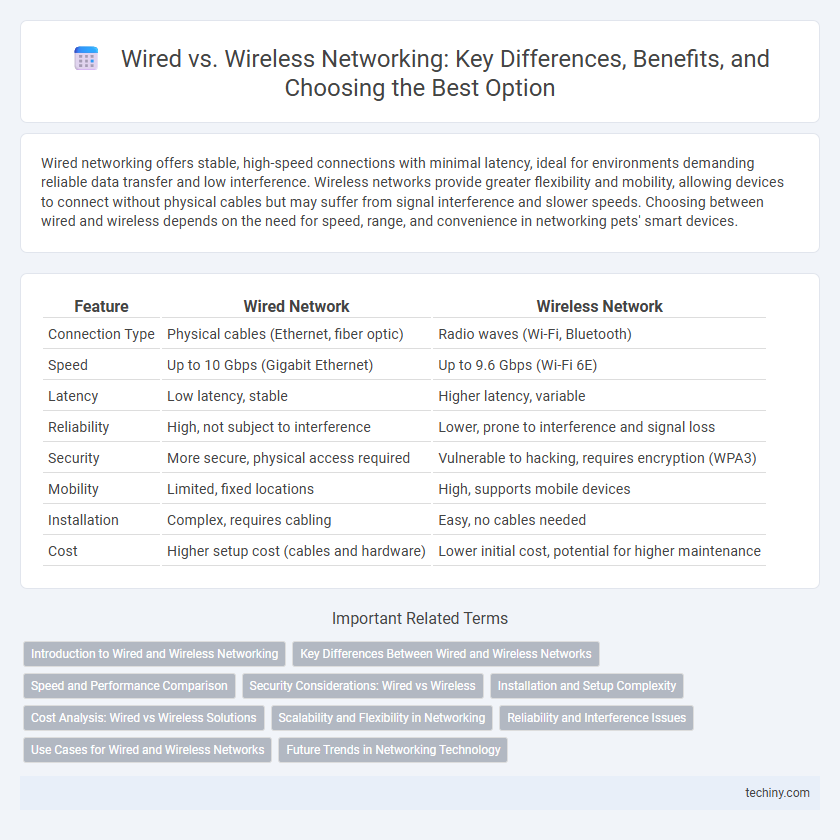Wired networking offers stable, high-speed connections with minimal latency, ideal for environments demanding reliable data transfer and low interference. Wireless networks provide greater flexibility and mobility, allowing devices to connect without physical cables but may suffer from signal interference and slower speeds. Choosing between wired and wireless depends on the need for speed, range, and convenience in networking pets' smart devices.
Table of Comparison
| Feature | Wired Network | Wireless Network |
|---|---|---|
| Connection Type | Physical cables (Ethernet, fiber optic) | Radio waves (Wi-Fi, Bluetooth) |
| Speed | Up to 10 Gbps (Gigabit Ethernet) | Up to 9.6 Gbps (Wi-Fi 6E) |
| Latency | Low latency, stable | Higher latency, variable |
| Reliability | High, not subject to interference | Lower, prone to interference and signal loss |
| Security | More secure, physical access required | Vulnerable to hacking, requires encryption (WPA3) |
| Mobility | Limited, fixed locations | High, supports mobile devices |
| Installation | Complex, requires cabling | Easy, no cables needed |
| Cost | Higher setup cost (cables and hardware) | Lower initial cost, potential for higher maintenance |
Introduction to Wired and Wireless Networking
Wired networking uses physical cables, such as Ethernet, to connect devices and ensure stable, high-speed data transmission with minimal interference. Wireless networking relies on radio waves, like Wi-Fi, to offer flexible device connectivity without physical constraints, enabling mobile access in various environments. Both wired and wireless networks are fundamental in modern communication systems, each serving unique purposes based on performance, mobility, and installation requirements.
Key Differences Between Wired and Wireless Networks
Wired networks offer higher stability and faster data transfer rates due to direct physical connections using Ethernet cables, while wireless networks provide greater mobility and ease of installation by utilizing radio frequency signals such as Wi-Fi or Bluetooth. Security in wired networks is generally stronger because physical access to the network cables is required, whereas wireless networks are more vulnerable to interference, signal loss, and unauthorized access if not properly encrypted. Latency and bandwidth limitations differ, with wired connections typically ensuring consistent performance, while wireless performance can fluctuate based on distance, obstacles, and network congestion.
Speed and Performance Comparison
Wired networks typically offer faster and more consistent speeds compared to wireless connections, with Ethernet providing stable gigabit or higher throughput ideal for high-bandwidth applications. Wireless networks, such as Wi-Fi 6, deliver flexibility and mobility but often experience variable speeds due to interference, signal strength, and network congestion. For optimal performance, wired connections minimize latency and packet loss, making them the preferred choice for gaming, streaming, and large data transfers.
Security Considerations: Wired vs Wireless
Wired networks offer superior security through physical connections that limit unauthorized access and reduce susceptibility to external breaches. Wireless networks require robust encryption protocols like WPA3 to prevent interception and unauthorized access over the airwaves. Implementing network segmentation and strong authentication methods enhances protection on both wired and wireless infrastructures.
Installation and Setup Complexity
Wired network installation typically requires physical cabling through walls or ceilings, demanding more time and technical expertise for proper setup and infrastructure planning. Wireless networks offer simpler installation with no need for extensive cabling, utilizing access points and routers to provide flexible coverage and easier scalability. However, wireless setups may require careful configuration to manage signal interference and security protocols effectively.
Cost Analysis: Wired vs Wireless Solutions
Wired networking solutions typically involve higher initial installation costs due to cables, switches, and labor but offer lower long-term maintenance and replacement expenses. Wireless networks reduce upfront infrastructure costs by eliminating physical cabling but may incur ongoing expenses from access point upgrades and signal interference troubleshooting. Analyzing total cost of ownership for wired versus wireless setups requires evaluating installation complexity, scalability needs, and expected network usage patterns.
Scalability and Flexibility in Networking
Wired networks offer high scalability through structured cabling that supports extensive device connections with stable bandwidth. Wireless networks provide unparalleled flexibility, enabling seamless mobility and rapid deployment across diverse environments without physical constraints. Scalability in wireless networks depends on spectrum availability and interference management, which can impact overall network performance.
Reliability and Interference Issues
Wired networks offer superior reliability due to stable physical connections that minimize packet loss and latency, critical for consistent data transfer in enterprise environments. Wireless networks, while providing greater mobility, are prone to interference from physical obstacles, electromagnetic signals, and other wireless devices, which can degrade signal quality and cause intermittent connectivity. Network engineers often implement advanced error correction and signal optimization techniques in wireless setups to mitigate these interference issues and enhance overall performance.
Use Cases for Wired and Wireless Networks
Wired networks offer optimal performance and security for environments requiring stable, high-speed connections such as data centers, corporate offices, and gaming setups. Wireless networks provide flexibility and mobility ideal for public spaces, remote work, and IoT device connectivity where ease of access and movement are critical. Enterprises and smart homes often integrate both technologies to balance bandwidth demands and user convenience efficiently.
Future Trends in Networking Technology
Emerging networking technologies highlight a shift towards hybrid models combining wired and wireless infrastructures to optimize speed, reliability, and flexibility. Innovations such as 5G and Wi-Fi 6E enhance wireless performance, while advancements in fiber-optic and Ethernet standards drive higher bandwidth and lower latency in wired connections. Integration of AI and edge computing in network management further accelerates adaptive connectivity, shaping future-proof communication ecosystems.
Wired vs Wireless Infographic

 techiny.com
techiny.com